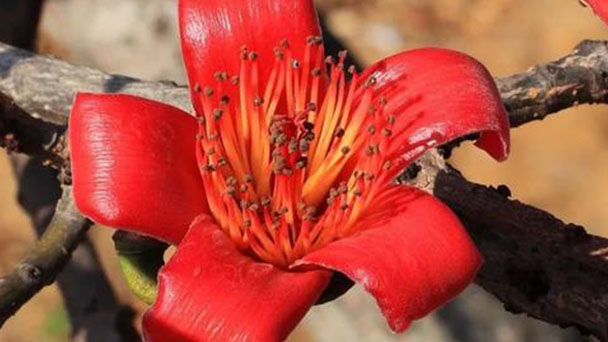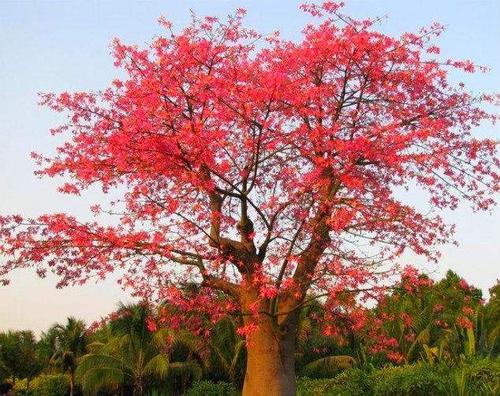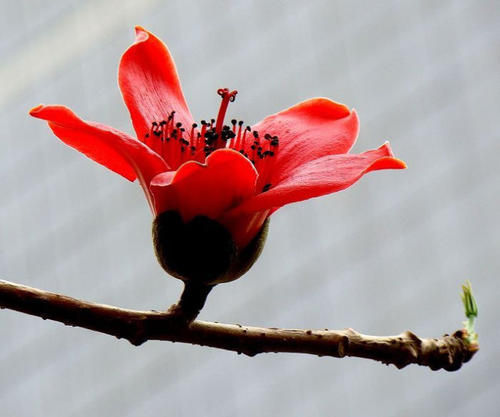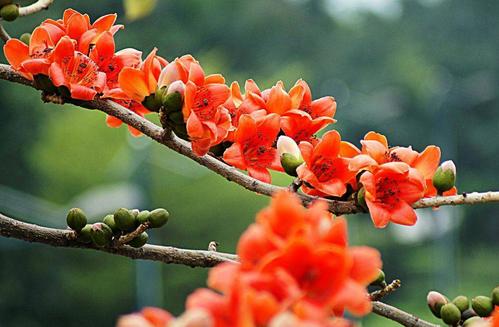Kapok profile
Written by Maggie
Jan 08 2021

Kapok, scientific name Ceiba pentandra, belongs to the family of kapok, deciduous large trees, native to India. Kapok is a large deciduous tree growing in tropical and subtropical areas, with a height of 10-25 m. The base of the trunk is densely burrowed with spines to prevent invasion by animals. Kapok’s appearance changes: in spring, a tree orange-red; In summer the leaves are shady; The autumn leaves are bleak; Bald branches and cold trees in winter, the four seasons show different scenes. Kapok is orange, flowering in March to April, first flowering and then leaves, tree shape with masculine beauty. Kapok flowers big and beautiful, towering trees, can be planted for garden ornamental trees, street trees.
Kapok picture

Kapok growth habits and distribution
Growth habit of Kapok
Kapok (Ceiba pentandra) likes a warm, dry and sunny environment, not cold-resistant, slightly wet, avoid water. Kapok is drought resistant, pollution resistant, wind resistant, deep roots, rapid growth, strong germination. The suitable temperature for growth is 20 ~ 30℃, and the winter temperature is not less than 5℃. It is suitable to grow in deep, fertile, and well-drained neutral or slightly acidic sandy soil.
The geographical distribution of Kapok
Kapok (Ceiba pentandra) was produced in Yunnan, Sichuan, Guizhou, Guangxi, Jiangxi, Guangdong, Fujian, Taiwan and other provinces and regions of subtropical. At an altitude of 1400-1700 meters below the dry hot river valleys and savanna, it can also grow in the gully monsoon rain forest but also cultivated for street trees. Kapok also distributed in India, Sri Lanka, Indo-China Peninsula, Malaysia, Indonesia to the Philippines and northern Australia.
Morphological characteristics of Kapok
Kapok (Ceiba pentandra) is a large deciduous tree, up to 25 meters high, with grayish bark, the trunks of young trees often have conical thick spines; Branches are spread flat. Leaves are palmately compound, leaflets 5-7, oblong to oblong-lanceolate, 10-16 cm long, 3.5-5.5 cm wide, apically acuminate, basally broad or tapered, entire, glabrous on both sides, pinnate lateral veins 15-17 pairs, ascending, with a slender lateral vein of grade 2, reticulate veins very fine, slightly raised on the second side; The petiole is 10-20 cm long and the stipule is small.
Flowers are solitary branches, axils of terminal leaves, usually red, sometimes orange-red, ca. 10 cm in diam. The calyx is cup-shaped, 2-3 cm long, glabrous outside, densely covered with yellowish short sericeous hair inside, calyx teeth 3-5, semicircular, 1.5 cm tall and 2.3 cm wide, petals fleshy, obovate-oblong, 8-10 cm long and 3-4 cm wide, stellate pubescent on both sides, but sparsely on the inside; The stamen tube is short, the filament is thick, the base is thick, tapering upward, the inner part of the filament is 2-forked, the middle 10 stamens are short, not bifurcated, the outer stamens are most, 5 bundles, each bundle of filament 10 or more, longer; The style is longer than stamen, and the capsule is oblong, obtuse, 10-15 cm long, 4.5-5 cm thick, densely covered with grayish-white villous and stellate pilose; Kapok has many seeds, obovate, smooth. The flowering period is from March to April, fruit mature in summer.
Kapok's appearance changes: in spring, a tree orange-red; In summer the leaves are shady; The autumn leaves are bleak; Bald branches and cold trees in winter, the four seasons show different customs. The flowers are orange-red, and the leaves fall into the flowering period in 2~ March each year, and then the leaves are long, and the tree forms a masculine beauty.

Propagation methods of Kapok
Propagation method: the seed breeding, from mid-June to mid-December, pods gradually mature, for 9 ~ 10 months to mature stage, mature fruit pods from the acquisition stage, sunlight insolate, emerge after cracking seeds. We can increase with the increasing mining sowing, seedling cold winter. We can also store seeds the following spring, seed kernels per 132 grams, germination temperature should be at 20 ℃ above, as of mid to late march spring planting is appropriate, with 60 ℃ warm water before planting a seed, continue to soak 12 hours after cooling, germinate fast, generally three days namely to germinate after sowing, germinated within a weekend, the germination rate of about 60 {bf}. With the method of sowing, seedling growth speed medium, seedling stage nitrogen fertilizer 2 ~ 3 times chase seedlings. After October, stop applying nitrogen fertilizer, potassium fertilizer consistent, promote early lignification, winter attention to cover and frost prevention, 1-year-old seedlings can be out of the nursery planting, 2 years old saplings, you can blossom for ornamental.
Natural reproduction is to make use of natural forces to produce fruit after Kapok and let the fruit naturally crack on the branches, and the oval seeds inside, together with the white cotton wool, will be scattered in the wind. So they can propagate.
Seedlings do not need to be transplanted, seedlings are too dense after a thinning, can be allowed to grow, top dressing 1 ~ 2 times a month. Seedlings afraid of frost, the first year into winter seedlings should be watered well with grass cover, frost prevention. Cottage seedlings after the shading, water, slow seedlings after half a month can be applied thin fertilizer, often after weeding tillage.
The main value of Kapok
Ornamental value
In early spring, Kapok (Ceiba pentandra) is in full bloom in February and March. It is beautiful. There is a saying in Guangdong that Kapok is open, but winter will never come again. In early February, it is the opening day of Kapok. In some places where Kapok trees are planted, brilliant flowers will emerge one after another. From a distance, the orange-red of a tree looks particularly vibrant.
Medicinal value
Kapok (Ceiba pentandra) efficacy: It has the function of clearing away heat and dampness and relieving summer heat. Bark has the function of dispelling wind and dehumidifying, activating blood and determination. Root has the function of dispersing the knot and relieving pain.
In addition to high ornamental value, kapok's flowers, skins and roots are of medicinal value. The dried Kapok porridge or soup, you can detoxify heat drive cold to wet; Kapok skin boiling water also has the effect of clearing away heat, diuresis and detoxification, and has a significant effect on chronic gastritis, gastric ulcer, diarrhea and dysentery.
Other value
The use of kapok (Ceiba pentandra) is also very wide, its stamens are very good fabric materials, ancient records "kapok trees high two-three zhangs, cut class paulownia, two or three months of flowers both Xie, the core for cotton. They weave it as a blanket, white as snow and warm."And the wood of kapok is soft, can make packing box board, match stem, wooden boat, barrel basin, etc., or the raw material of papermaking.
Kapok flowers in February to March every year, then long leaves. The corolla is five-petaled, orange-yellow or orange-red, usually in early spring, appearing before the leaves. The calyx is dark brown, leathery. Since cotton is not grown in southern China, local residents have collected cotton wool over the years to replace it as a filling material for their cotton-padded jackets.
Kapok flower language
Kapok's motto: cherish the people around you! Cherish the present happiness!

Latest Updated
- Benefits of Bugleweed - 7 Science-backed Health Benefits
- Bugleweed Dangers & Side Effects - Is It Poisonous?
- How to Plant Evergreen Trees - What You Should Know
- When to Plant Evergreens - Grow Guide for Evergreen Trees
- 12 Wonderful Evergreen Shrubs for Your Garden
- 12 Popular Evergreen Plants with Pictures for Beginners
- When And How To Prune A Lilac Bush Like a Pro
- How to Grow & Care for Lilac Vine (Hardenbergia Violacea)
- Japanese Lilac Tree (Syringa Reticulata) Care & Propagation Guide
- Shumard Oak Pros and Cons - What to Know
Popular Articles
- Winter maintenance of Antirrhinum Majus
- How to Grow Terminalia Mantaly Tree
- How to Grow and Care for Crossostephium Chinense
- How to grow Antirrhinum Majus in spring
- Peristeria Elata (Dove Orchid) Profile: Info & Care Guide
- Underwatered Snake Plant (Sansevieria Trifasciata) - Signs And How To Fix
- How to Care for Brazilian Jasmine Plant (Mandevilla Sanderi)
- How to Grow & Care for Graptopetalum Purple Delight in Summer
- Rosa Chinensis (China Rose): Plant Growing & Care Tips
- How to Care for Baby Sun Rose (Aptenia Cordifolia)